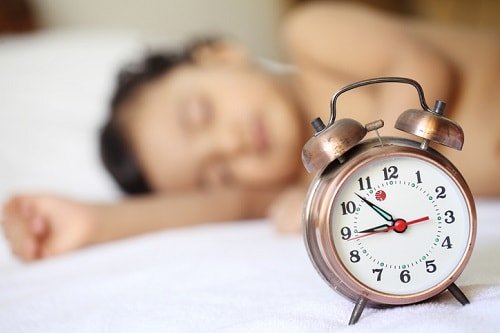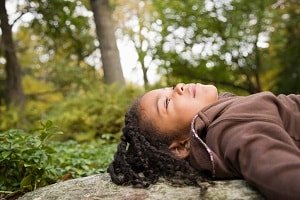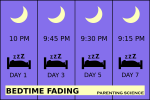How can we help kids adapt to an earlier schedule? Morning sunlight, exercise, and other environmental cues can help reset a child’s internal clock. But to make sure kids feel physiologically drowsy at bedtime, we need to use additional strategies.

Understanding the big picture: How circadian rhythms, daytime naps, and social factors impact your child’s ability to feel drowsy at bedtime
Maybe you’ve got a kid who stays up too late. Or maybe you need to prepare your child for a new schedule.
Either way, you face a problem. Your child isn’t falling asleep early enough at night.
Trying to force the issue is counterproductive. You can’t make a child fall asleep on command.
Sleep is regulated by an internal clock — our circadian rhythms — and a key ingredient in the process is the hormone, melatonin.
When all goes well, we experience a surge in melatonin after nightfall. This sudden rise triggers feelings of drowsiness, making it easy for us to fall asleep.
But the precise timing varies from individual to individual, and this is true in children as well as adults. What happens if we pressure children to sleep before their brains experience the surge in melatonin?
Failure. Conflict. Bad feelings. And research confirms this is a widespread problem, particularly for young children. These kids can’t fall asleep, and it isn’t their fault. Their circadian rhythms are out of sync with their official bedtime (LeBourgeois et al 2013).
So you might assume that the solution focuses on reprogramming the internal clock, and that’s not totally wrong.
But it’s an incomplete solution, because circadian processes aren’t the only processes that affect sleep.
We don’t just have an internal clock. We also have an internal “battery.”
When we wake up after a restful night’s sleep, we feel refreshed and alert. It’s as if we’re beginning the day with a freshly-charged battery.
But the longer we remain awake, the more that battery drains. We feel an ever-increasing, physiological pressure to asleep.
When we finally doze again, we start to reduce this “sleep pressure.” The battery begins to recharge. A brief nap will help purge that drowsy feeling for a while. A long nap may recharge our battery for many hours. And if we take a long nap too late in the day, we may find it very difficult to fall asleep at bedtime — even if our internal clock is telling us that it’s late at night.
Moreover, our brains aren’t slaves to either of these systems — the internal clock and the battery. A timely surge of melatonin, and sleep pressure, won’t guarantee that you’ll fall asleep.
Our brains are also equipped with a kind of emergency override, a system that keeps us awake when we’re anxious, stressed, or otherwise excited.
And what’s a common trigger of such feelings at night?
Battles over bedtime.
Put it all together, and you can see why trying to force sleep is a bad idea.
It isn’t just pointless and futile. If bedtime conflicts cause stress, you’ll have made it even harder for your child to become drowsy. And beware the long-term consequences.
With repeated, nightly conflicts, your child will be learning all the wrong lessons. Instead of learning to associate your calls for bedtime with calmness and drowsiness, your child will be learning to associate bedtime with feeling alert, distressed, or restless.
In effect, you could be training your child to develop the mental habits that can cause chronic insomnia.
So if you want to get your child adapted to an earlier bedtime, you need to pay attention to the big picture. You need a solution that addresses all the factors that contribute to your child’s sleep habits.
- You need to make sure bedtime isn’t confrontational.
- You need to make sure that late afternoon naps aren’t recharging your child’s “battery.”
- You need to approach your goal in steps. Begin by setting an official bedtime that accommodates your child’s current internal clock. Don’t ask your child to go to bed before he or she starts feeling drowsy.
With this groundwork covered, you’re ready to start the process of resetting your child’s internal clock. Here’s what’s next.
How to reprogram a child’s internal clock
Whether we’re night owls or early birds — or something in between — we all have the ability to shift our circadian rhythms.
In fact, the circadian system is designed to operate this way. We can reset our internal clock by providing it with the right environmental cues, or “zeitgebers.” And what’s the most powerful cue of them all? Light.
If you want your child to fall asleep earlier at night, expose your child to bright, morning light.

What do I mean by “bright” light? The short answer is at least 10,000 lux — the level of light intensity emitted by a bright light therapy box.
That’s much brighter than the typical electrical lighting in your home. For instance, when you turn on the lights in your living room, light levels are probably less than 100 lux.
But you don’t have to use a light therapy box to provide your child with the necessary illumination. When it comes to brightness, nothing beats the sun.
Even on a dreary, overcast day, the outdoor illumination level is likely to reach 1000 lux. And when the skies are clear, daytime illumination can range from 10,000 to 100,000 lux.
So just going outdoors — or allowing your child to soak in the rays streaming through a bright window — can do the trick.
When exactly should these bright light sessions take place?
Ideally, around the time your child wakes up in the morning — or within the first hour of waking. And to establish a well-tuned internal clock, regularity is important. Try to wake up at the same time each day.
How long should sessions last?
Thirty minutes may be sufficient.
In clinical studies using bright light box therapy, children and youth have experienced improvements on just 30 minutes of bright light exposure each morning. Within a couple of weeks, they began to produce melatonin much earlier in the evening, and they fell asleep earlier at night (van Maanen et al 2017; Saxvig et al 2014; Takasu et al 2006).
What about light during the afternoon? Is that helpful too?
There are hints that light exposure in the morning has the most potent effect on a child’s day. But yes, light in the afternoon is helpful too.
In fact, there’s even evidence that exposure to natural lighting at sunset is helpful.
During sunset, light rays are bent, producing a special mix of wavelengths, and these wavelengths appear to send a message when they hit the back of our retinas — informing the inner clock that night is approaching (Patterson et al 2020).
And naps? When kids take naps during the daytime, should they sleep in a darkened room? Or is it better to nap in the light?
I haven’t found any experimental studies testing this in children. But an experiment on young adults suggests that napping in a well-lit room can help us fall asleep earlier at night.
In this study, twelve young men stayed awake throughout the night. Then, the next morning, they got some catch-up sleep. But the conditions varied:
- Half the men were assigned to sleep in dimly-lit room (under 50 lux).
- The other half were assigned to sleep in a brightly lit room (3000 lux).
Later that evening, the researchers monitored the rise of melatonin levels in each man. And the results favored the men who’d napped under brightly-lit conditions. Their melatonin levels rose earlier in the evening (Nagashima et al 2018).
What about nighttime? Is it true that artificial light keeps kids awake?
Yes. Experiments demonstrate that exposure to artificial lighting at night delays the brain’s release of melatonin, and children seem to be especially sensitive. So it’s important to keep lighting dim in the evening, and be careful about your child’s use of electronic screens before bedtime. To learn more about it, see this Parenting Science article.
What else can we do to reset the internal clock?
A technique called “bedtime fading” can help you adjust your child’s bedtime in a gradual, easy way.

Is your goal to shift bedtime more than 15-20 minutes? If so, you shouldn’t expect it to happen all at once. It’s a lot like coping with jet lag. You don’t adjust to a new time zone immediately. It takes days — sometimes many days — to fully adapt to the new schedule.
The sleep training technique known as “bedtime fading” can help you break the process in a realistic way. I explain the technique in this article about infant sleep problems.
Bedtime routines are also helpful.
A bedtime routine consists of calm, pre-bedtime activities, like bathing, getting dressed in pajamas, and reading a soothing bedtime story (Staples et al 2015; Mindell et al 2015).
Such routines function as social cues about the time of day. But they do more besides. The low-key activities help children wind down. And the predictability itself is reassuring. Kids know what to expect. In this way, bedtime routines can make children feel more secure, which is crucial for timely sleep. Your child will be less likely to experience the negative emotions that keep kids alert at night.
Tryptophan and carbohydrates might have an impact, albeit a modest one.
Tryptophan is an amino acid that helps your body synthesize melatonin at night. It’s found in certain foods. And carbohydrates can increase the absorption of tryptophan into the brain. So you might think that eating a meal rich in tryptophan and carbs would make an individual fall asleep faster or earlier at night. What do experimental studies tell us?
Experiments on adults suggest that a high-carb meal in the hours before bedtime can contribute to a slightly quicker transition to sleep. After going to bed, people drowsed off about 5-10 minutes faster (St-Onge et al 2016). In addition, some studies have tested the effects of a high-tryptophan breakfast, and found that higher tryptophan at breakfast is linked with earlier bedtimes in toddlers and young, school-aged children (Nakade et al 2012; Harada et al 2007). But these links were present only when kids were also exposed to morning sunlight.
What about the timing of meals? It’s crucial to avoid caffeine in the hours leading up to bedtime. But when it comes to healthful, non-caffeinated foods, the evidence is unclear.
For example, in a study of 87 school-aged children, researchers found that kids who fell asleep later at night tended to eat later. Their first meal of the day (breakfast, brunch, or lunch) occurred later. They also consumed more calories after dinner each night (Spaeth et al 2019).
But what was cause, and what was effect? Maybe it’s just that going to bed later makes you shift the timing of your meals. Kids with earlier bedtimes are more likely to eat breakfast (Thivel et al 2015), but that alone doesn’t tell us that eating breakfast causes earlier bedtimes.
Adults who eat late are more likely to experience night wakings. But they don’t seem to fall asleep any faster at the beginning of the night (Chung et al 2020).
Exercise can contribute to an earlier onset of the melatonin surge in the evening. But be careful about the timing!
The evidence comes from an experiment on previously sedentary, young adults.
Researchers found that exercise sessions helped people fall asleep earlier at night. But the precise effects depended on an individual’s “chronotype,” or habitual sleep profile.
For individuals who were confirmed “night owls,” exercise was always helpful. Whether their new exercise sessions happened in the morning or evening, these people experienced earlier surges of melatonin at night.
By contrast, people with earlier chronotypes (those tending to be “early birds” or “larks”) had a different experience. While morning exercise led to earlier evening melatonin surges, evening exercise had the opposite effect: It delayed the onset of evening melatonin (Thomas et al 2020).
We can’t know for sure what this means for children. The research hasn’t focused on them. But it’s reasonable to assume that morning exercise is helpful for getting kids to adapt to an early bedtime.
Evenings? Until we learn more, I’d avoid experimenting with vigorous activity unless you know you’ve got a night owl.
And what if my pediatrician prescribes melatonin supplements?
If your child has a circadian rhythm sleep disorder, a sleep specialist might prescribe melatonin. But should you self-diagnose, and give your child over-the-counter supplements? No, researchers warn. It’s a bad idea.
At present, we know too little about the effects of melatonin supplements on children. Melatonin is a powerful hormone. Among other worries, researchers are concerned that it could change the timing of puberty (Boafo 2019).
More information about solving sleep problems in children
For additional help, see these Parenting Science articles:
- Bedtime problems in children: Solutions for the science-minded
- Infant sleep problems: A trouble-shooting guide
- Melatonin, milk, and breast pumps: How the timing of breast milk production might affect infant sleep
- How television affects sleep
- Tech at bedtime: Do electric devices cause sleep problems in children?
- Night wakings: A guide for the science-minded parent
- Nighttime fears in children
References: How to reset your child’s internal clock
Boafo A,, Greenham S, Alenezi S, Robillard R, Pajer K, Tavakoli P, De Koninck J. 2019. Could long-term administration of melatonin to prepubertal children affect timing of puberty? A clinician’s perspective. Nat Sci Sleep. 31;11:1-10.
Chung N, Bin YS, Cistulli PA, and Chin Moi Chow CM. 2020. Does the Proximity of Meals to Bedtime Influence the Sleep of Young Adults? A Cross-Sectional Survey of University Students. Int J Environ Res Public Health. 2020. 17(8): 2677.
Harada T, Hirotani M, Maeda M, Nomura H, Takeuchi H. 2007 Correlation between breakfast tryptophan content and morning-evening in Japanese infants and students aged 0-15 yrs. J Physiol Anthropol. 26(2):201-7.
LeBourgeois MK, Carskadon MA, Akacem LD, Simpkin CT, Wright KP Jr, Achermann P, Jenni OG. 2013. Circadian phase and its relationship to nighttime sleep in toddlers. J Biol Rhythms. 2013 Oct;28(5):322-31.
Mindell JA, Li AM, Sadeh A, Kwon R, Goh DY. 2015. Bedtime routines for young children: a dose-dependent association with sleep outcomes. Sleep. 38(5):717-22.
Mistlberger RE, Skene DJ. 2005. Nonphotic entrainment in humans? J Biol Rhythms. 20(4):339-52.
Mistlberger RE, Skene DJ. 2004. Social influences on mammalian circadian rhythms: animal and human studies. Biol Rev Camb Philos Soc 79(3): 533-56.
Nakade M, Akimitsu O, Wada K, Krejci M, Noji T, Taniwaki N, Takeuchi H, Harada T. 2012. Can breakfast tryptophan and vitamin B6 intake and morning exposure to sunlight promote morning-typology in young children aged 2 to 6 years? J Physiol Anthropol. 31(1):11.
Patterson SS, Kuchenbecker JA, Anderson JR, Neitz M, Neitz J. 2020. A Color Vision Circuit for Non-Image-Forming Vision in the Primate Retina. Curr Biol. 30(7):1269-1274.e2.
Saxvig IW, Wilhelmsen-Langeland A, Pallesen S, Vedaa O, Nordhus IH, Bjorvatn B. 2014. A randomized controlled trial with bright light and melatonin for delayed sleep phase disorder: effects on subjective and objective sleep. Chronobiol Int. 31(1):72-86.
Spaeth AM, Hawley NL, Raynor HA, Jelalian E, Greer A, Crouter SE, Coffman DL, Carskadon MA, Owens JA, Wing RR, Hart CN. 2019. Sleep, energy balance, and meal timing in school-aged children. Sleep Med. 60:139-144.
Staples AD, Bates JE, and Petersen IT. 2015. Ix. Bedtime routines in early childhood: prevalence, consistency, and associations with nighttime sleep. Monogr Soc Res Child Dev. 80(1):141-59.
St-Onge M-P, Mikic A, and Pietrolungo CE. 2016. Effects of Diet on Sleep Quality. Adv Nutr. 7(5): 938–949.
Takasu NN1, Hashimoto S, Yamanaka Y, Tanahashi Y, Yamazaki A, Honma S, Honma K. 2006. Repeated exposures to daytime bright light increase nocturnal melatonin rise and maintain circadian phase in young subjects under fixed sleep schedule. Am J Physiol Regul Integr Comp Physiol. 291(6):R1799-807.
Thomas JM, Kern PA, Bush HM, McQuerry KJ, Black WS, Clasey JL, Pendergast JS. 2020. Circadian rhythm phase shifts caused by timed exercise vary with chronotype. JCI Insight. 5(3). pii: 134270.
van Maanen A, Meijer AM, Smits MG, van der Heijden KB, Oort FJ. 2017. Effects of Melatonin and Bright Light Treatment in Childhood Chronic Sleep Onset Insomnia With Late Melatonin Onset: A Randomized Controlled Study. Sleep. 40(2).
Title image of clock with child sleeping in the background by Matrix Images / istock
Image of girl lying in the woods looking at the sky by XiXinXing / istock
image of bedtime fading schedule by Parenting Science
Content last modified 6/2020